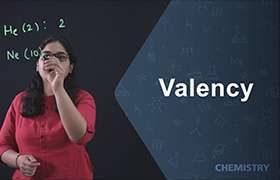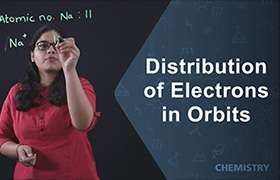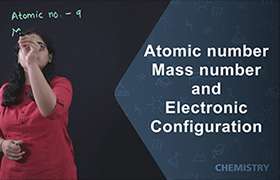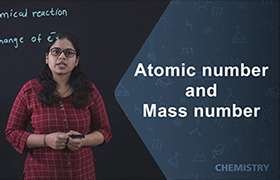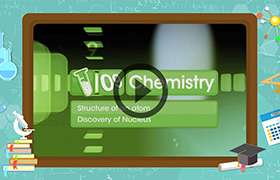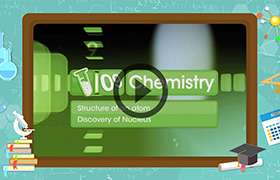CBSE Class 9 Answered
answer Questions in detail
Asked by sunnyjune30 | 22 Jan, 2011, 11:03: AM
Dear Student
Canal Rays: Anode rays (or canal rays) are beams of positive ions that are created by certain types of gas discharge tubes. They were first observed in Crookes tubes during experiments by the German scientist Eugen Goldstein, in 1886.
Properties of Anode Rays
- Travel in straight lines. They cast a shadow of the objects placed in their way.
- Produce mechanical effectA paddle wheel placed in their path starts rotating.
- Rays are positively chargedWhen an electric field is applied in the path of anode rays, they are deflected towards the negative plate of an electric field.
- The nature of the anode rays depends upon the gas taken in the discharge tube. Different gases give different types of positive rays, which contain particles having different masses and different charges. Therefore the e/m ratio is not constant for positive ray particles obtained from different gases.
Cathode Rays: Cathode rays (also called an electron beam or e-beam) are streams of electrons observed in vacuum tubes, i.e. evacuated glass tubes that are equipped with at least two metal electrodes to which a voltage is applied, a cathode or negative electrode and an anode or positive electrode. They were first observed in 1869 by German physicist Johann Hittorf, and were named in 1876 by Eugen Goldsteinkathodenstrahlen, or cathode rays. Electrons were first discovered as the constituents of cathode rays. In 1897 British physicist J. J.
Thomson showed the rays were composed of a previously unknown negatively charged particle, which was later named the electron.Cathode ray tubes (CRTs) create the image in a classic television set.
Some suggested that cathode rays might be waves, like light or the recently discovered x-rays. But waves, as far as anyone knew then, couldn't carry electric charge; only particles could do that. That's why Thomson's experimental results convinced him that cathode rays had to be made up of particles.
Properties of Cathode rays :
- They travel in straight lines from the cathode to the anode. (When an object is placed in the path of a cathode ray in the discharge tube, the light gets blocked in the area of the object and fluorescence is seen only in regions outside the shadow. Further it casts a shadow away from the cathode, on the opposite side).
- The rays consist of material particles and can produce a mechanical effect. (When a small paddle wheel is placed between the electrodes of the discharge tube, it rotates).
- These material particles are charged particles with a negative charge. (When cathode rays are exposed to electrical or magnetic fields, they deflect towards the positively charged plate.)
- They have a heating effect (when they strike a thin metal foil it gets heated up.)
- They produce fluorescence or glow upon striking glass or certain other materials.
- They produce X-rays when they strike hard metals like copper, tungsten etc.
- They penetrate through thin sheets of aluminium or other metal.
- Cathode rays effect photographic plates.
- The ratio of charge to mass i.e. charge/mass is the same for all the cathode rays irrespective of the type of gas used in the tube.
The above observations lead us to conclude that cathode rays consist of negatively charged particles called electrons.
We hope that clarifies your query.
Regards
Team
Topperlearning
Answered by | 22 Jan, 2011, 01:15: PM
Application Videos
Concept Videos
CBSE 9 - Chemistry
Asked by shivalaxmi0205 | 08 Mar, 2023, 07:47: PM
CBSE 9 - Chemistry
Asked by rekhachaturvedu422 | 01 Aug, 2022, 04:16: PM
CBSE 9 - Chemistry
Asked by pandeyabhishek1576 | 16 Feb, 2022, 01:24: PM
CBSE 9 - Chemistry
Asked by senniasamy | 10 Jan, 2022, 08:48: PM
CBSE 9 - Chemistry
Asked by nathdarshana | 20 Nov, 2020, 07:03: PM
CBSE 9 - Chemistry
Asked by archanakad | 25 Aug, 2020, 08:59: PM
CBSE 9 - Chemistry
Asked by namyairmalwar9803.5sdatl | 07 Jun, 2020, 01:47: PM
CBSE 9 - Chemistry
Asked by fathima1012006 | 31 May, 2020, 10:44: AM
CBSE 9 - Chemistry
Asked by gspublicschool | 27 Apr, 2020, 11:23: AM
CBSE 9 - Chemistry
Asked by Jaiwanthsiva | 15 Apr, 2020, 01:51: PM


